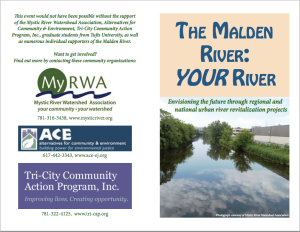For all the unique challenges confronting the Malden River, there are also many commonalities with other river stories; obstacles that other communities have encountered and overcome. Advocates and residents of the Malden River communities can take courage and find inspiration in the following stories-turned-case studies.
 These tell the stories of ordinary people accomplishing exceptional things, and the strategies that aided them. The case studies in this section were qualified because they fit a certain profile, which could be described as urban rivers facing a myriad of challenges. These include dense population, a history of industrial pollution, environmental justice issues, public health concerns, stigmas of danger, limited public access to the river, and urban blight. The common successes include community engagement, vision-setting, community determination of outcomes, and ultimately, a substantive change to how residents interact with the river.
These tell the stories of ordinary people accomplishing exceptional things, and the strategies that aided them. The case studies in this section were qualified because they fit a certain profile, which could be described as urban rivers facing a myriad of challenges. These include dense population, a history of industrial pollution, environmental justice issues, public health concerns, stigmas of danger, limited public access to the river, and urban blight. The common successes include community engagement, vision-setting, community determination of outcomes, and ultimately, a substantive change to how residents interact with the river.
These case studies offer a broad overview of the successful community -based movements addressing the Los Angeles River in California, the Spicket River in Massachusetts, and Mill Creek in Ohio. Each gives a unique set of insights ranging from branding, to fund raising, and community engagement. It is likely that every reader will be able extract a unique set of insights and wisdom from these narratives. We have attempted to draw out the richest content from the available sources and produce a distilled version that can be quickly digested and applied to the Malden River.
Much of this content informs the recommendations laid out in the strategic memo, found later in this document. For instance, the strategies employed by groups like the Friends of the Los Angeles River (FoLAR) have been recommended in a tailored version for re-envisioning the Malden River. Through this, we hope to provide advocates of the Malden River with a foundation of literature review, enabling readers to benefit from the experience of those who have gone before. A collection of literature was identified by following the sources that informed these case studies.
Reviewing the literature and creating the subsequent case studies provided the practicum team with a conceptual anchor from which to form a project. This was important, as the team was challenged to create meaningful contributions to a resident group whose formation was hoped for, but not yet realized. For those on the team who had not previously engaged in community organizing events, the case studies offered a window into the sphere of community engagement. Understanding the 30-year time frame of the Los Angeles River is sobering, but it creates a realistic expectation of the scale of time and caring that is necessary for such movements to succeed.
River revitalization efforts were studied on three urban waterways: the Los Angeles River in California, the Spicket River in Massachusetts, and the Mill Creek in Ohio. Community organizing efforts on these three rivers were selected, in particular, due to similarities in parameters such as population density, a history of industrial pollution in the river, and population demographics (e.g. environmental justice communities).
